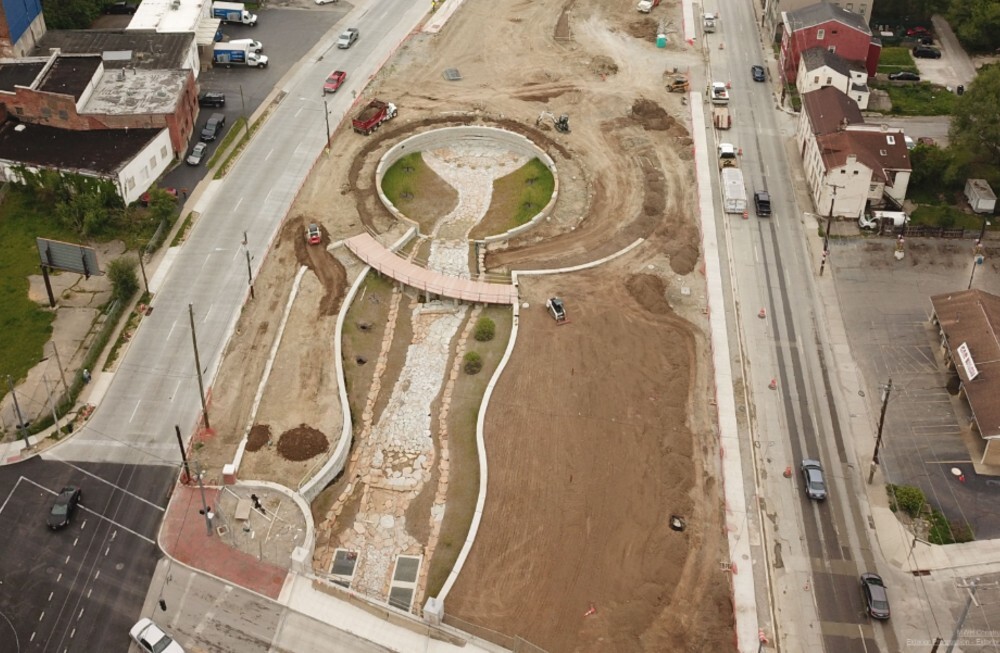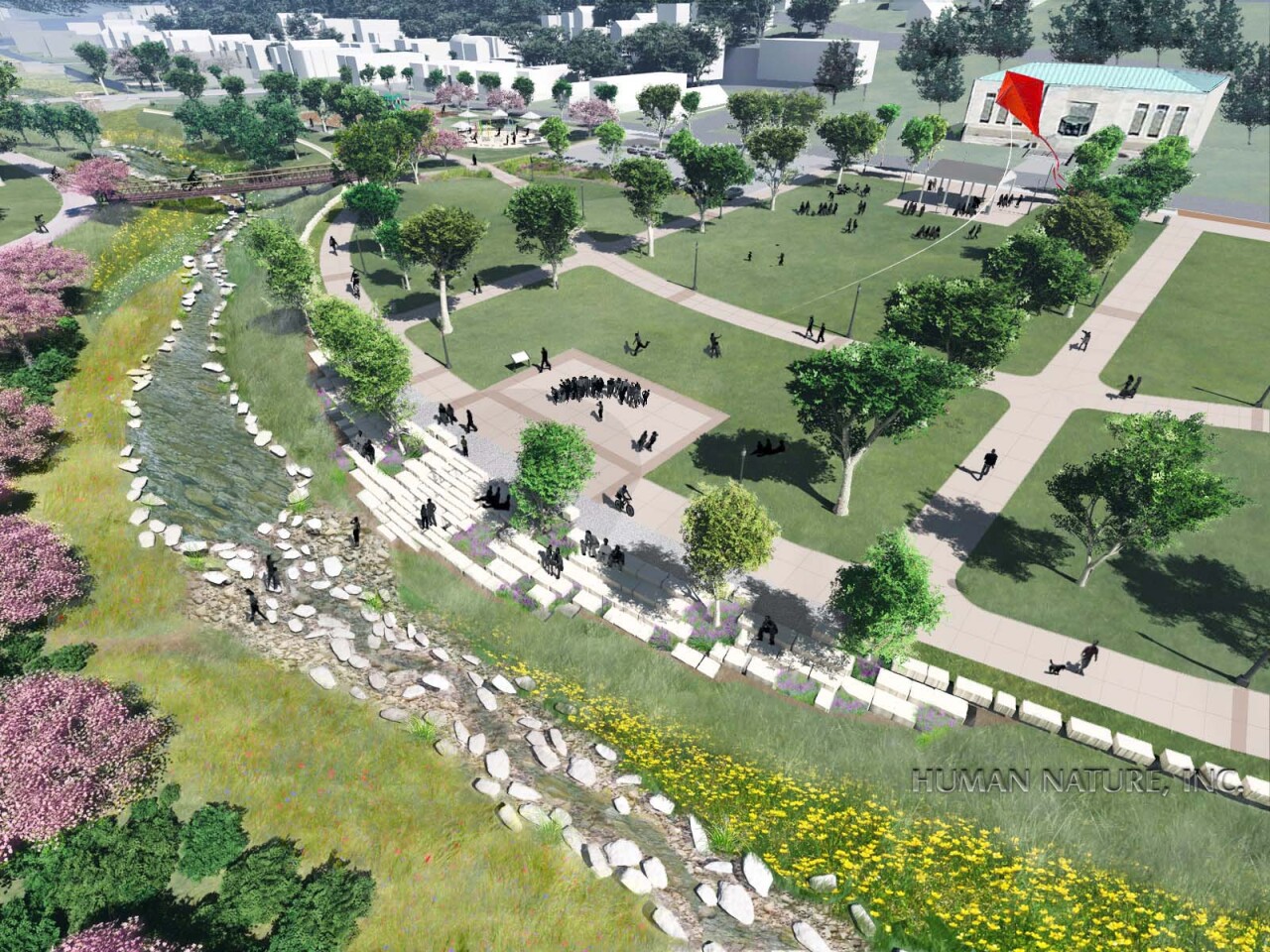For three years, many West Side drivers have had to put up with detours and traffic jams from roadwork, demolition and construction along one of the city’s main routes.
Others went out of their way just to avoid the traffic headaches on westbound Queen City Bypass and eastbound Westwood Avenue.
Now drivers are starting to see what the commotion was all about. Most of the roadwork is finished, and the Lick Run Greenway is starting to come alive.
“It’s looking great. The plants are growing in,” said Deb Leonard, Communications Manager for the Metropolitan Sewer District. “It’s going to be really beautiful.”

Ten years ago, MSD started planning a multi-million-dollar project to comply with EPA demands to drastically reduce hundreds of millions of gallons of sewage from homes and businesses that was overflowing into the Mill Creek, along Interstate 75. MSD came up with a radical partly “green” solution to separate stormwater from sewage while also beautifying the South Fairmount valley.
In a matter of months now, hundreds of trees, a blanket of new grass and other greenery should transform what has been a muddy-brown, 1.5-mile construction site into a picturesque park – complete with a meandering 1-mile stream, walking path, stage and recreation area – in what used to be a rundown stretch of homes and businesses.
The stream is just one part of that solution. So is a 1.5-mile underground conveyance box that workers installed after construction started in 2017.
SEE an interactive map of the Lick Run Greenway.
Project planners expect the Lick Run Greenway to cut about 400 million gallons of Combined Sewage Overflows (CSOs) per year.
Like most big government projects, it’s running behind schedule and over the original estimated cost.

“If you drive past the project this summer, you will see native grasses coming in along the stream corridor, and many trees and shrubs being planted throughout the project area,” said MSD Director Diana Christy, who answered an emailed list of questions from WCPO 9.
“The project is expected to be completed by the end of 2020, but some restoration work and landscaping could extend into spring 2021. Turf grass seeding is not expected to occur until this fall or spring 2021. The project has a two-year establishment period for plants, so expect a full bloom by spring 2022.”
The name of the project comes from area’s polluted past, according to Christy.
“Lick Run is the name of the stream that used to flow through the valley area of South Fairmount prior to the 1890s,” Christy said.
“The stream was enclosed in a 20-foot-diameter storm sewer in 1893 as a means of controlling flooding in the area. After indoor plumbing was introduced, houses were plumbed into the storm sewer, thus creating what is known as a combined sewer – or a sewer that carries both rainwater and sanitary sewage.“
By the 1900s, the Lick Run stream would fill with sewage during rainstorms.
How Will The Lick Run Greenway Work?
“We are basically recreating the original Lick Run stream and drainage system through bioengineering,” Christy said.

The project is designed to help solve a problem Cincinnati shares with many cities where older sewer systems mix rainwater and sewage. During a heavy rain, the water overwhelms capacity at sewage treatment plants, forcing CSOs into nearby waterways.
The Lick Run Greenway is actually part of a comprehensive Lick Run Project that includes 11 other projects to capture and convey stormwater. The Lick Run watershed includes 2,900 acres in South Fairmount and parts of East Price Hill, West Price Hill and Westwood, according to the Lick Run website.
The genius of the Lick Run plan is that it uses multiple environmentally-friendly elements to gather stormwater and convey it to the Mill Creek.

“MSD has constructed dedicated storm sewers along all the main roads and aboveground stormwater conveyance systems (e.g., bioswales, restored streams) in ravines throughout the watershed,” Christy said.
These systems capture rainwater and convey it directly to the Lick Run Greenway in the area of Queen City Bypass and old Queen City Avenue, Christy said. That’s where the stream originates.
Stormwater is either distributed into the stream during low-flow days or into both the stream and the underground stormwater conveyance box during high-flow days, Christy said.
“The underground conveyance box is for stormwater only and is not to be confused with the 20-foot-diameter combined sewer. The box was constructed to manage water during heavy rainstorms and control flooding in the stream channel,” she said. “Think of the box like an expressway for stormwater to the Mill Creek, while the stream channel is the local route.”
WATCH drone video of the site on April 22, 2020.
Sanitary sewage will continue to discharge from homes and businesses into the 20-foot-diameter combined sewer, Christy said.

“This flow is taken to our Mill Creek Wastewater Treatment Plant. Some rainwater will continue to be discharged into the combined sewer, but much less than before. The significant reduction in the volume of stormwater in the combined sewer is what accounts for the significant reduction in sewer overflows into the Mill Creek.”
The stream will actually carry stormwater to a 2-acre pond near Harrison Avenue for discharge, Christy said. There, some water will be recirculated to keep the stream flowing continuously.
“The Lick Run watershed does not receive enough spring-fed water or rainwater to naturally charge a stream year-round,” Christy said. “The original Lick Run only flowed during and after rainstorms … If MSD did not recirculate the water from the pond, the stream channel would run dry much of the year.”
The Lick Run Greenway will also provide plenty of beauty and recreation in the form of:
- Headwaters Park on Queen City Bypass between Quebec Road and White Street.
- A walking path with a bridge, landscaping, lighting and security railings.
- Wetland and rain gardens along Queen City Bypass.
- New playground basketball courts, a concrete stage area, a shelter and the existing water sprayground.
In addition, off-street parking will be available at Headwaters Park and the recreation area between Grand and Harrison avenues.

MSD is not planning to open the Greenway until the entire project is complete, according to Christy.
MSD estimates that final project costs will be “in the $110-$120 million range,” Christy said.
The original cost estimate was $105.8 million and Kokosing Industrial made the low bid at bid $89.8 million, she said.
“Since the start of the project, MSD has approved $11.1 million in change orders for a new contract total of $101 million,” Christy said. “The primary reason for the increased costs is utility conflicts (needing to relocate other utilities such as water, gas, electric, cable, etc.) and unforeseen subsurface conditions (e.g., contaminated soil, tanks), which is not unexpected given the age, density, and historical industrial uses of this urban corridor.”
Final repaving work on Queen City Bypass between White Street and Lick Run Way should be finished soon, according to MSD. The work date will be announced here along with other traffic updates.









